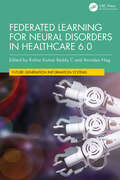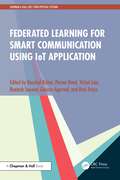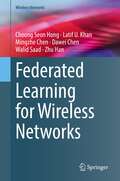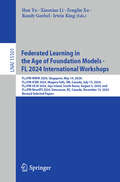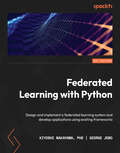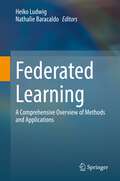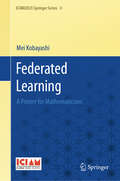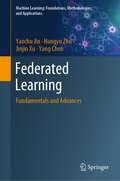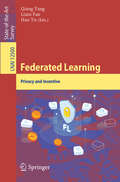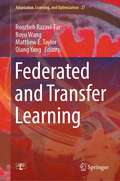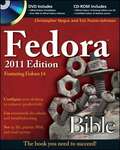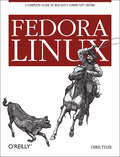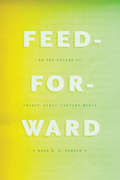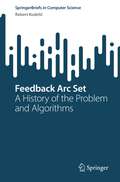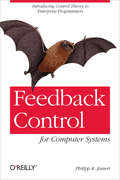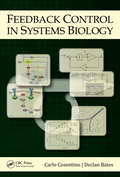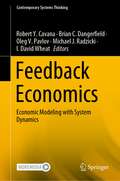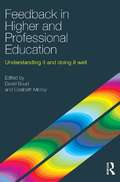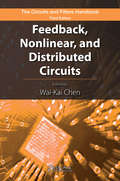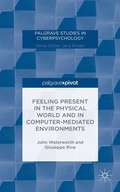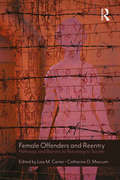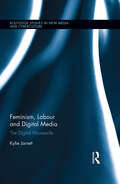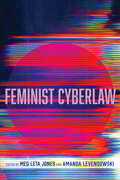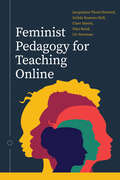- Table View
- List View
Federated Learning for Neural Disorders in Healthcare 6.0 (Future Generation Information Systems)
by Anindya Nag Reddy C, Kishor KumarThis reference text offers a relevant and thorough examination of the overlap between neuroscience and federated learning. It explores the complexities of utilizing federated learning algorithms for MRI data analysis, demonstrating how to improve the accuracy and efficiency of diagnostic procedures. The book covers topics such as the prediction and diagnosis of Alzheimer’s disease using neural networks and ensuring data privacy and security in federated learning for neural disorders.This book: Provides a thorough examination of the transformative impact of federated learning on the diagnosis, treatment, and understanding of brain disorders Focuses on combining federated learning with magnetic resonance imaging (MRI) data, which is a fundamental aspect of contemporary neuroimaging research Examines the use of federated learning as a promising approach for collaborative data analysis in healthcare, with a focus on maintaining privacy and security Explores the cutting-edge field of healthcare innovation by examining the interface of neuroscience and machine learning, with a specific focus on the breakthrough technique of federated learning Offers a comprehensive understanding of how federated learning may transform patient care, covering both theoretical ideas and practical examples It is primarily written for graduate students and academic researchers in electrical engineering, electronics, and communication engineering, computer science and engineering, and biomedical engineering.
Federated Learning for Smart Communication using IoT Application (Chapman & Hall/CRC Cyber-Physical Systems)
by Kaushal Kishor Vishal Jain Gaurav Agarwal Parma Nand Neetesh Saxena Rani AstyaThe effectiveness of federated learning in high‑performance information systems and informatics‑based solutions for addressing current information support requirementsis demonstrated in this book. To address heterogeneity challenges in Internet of Things (IoT) contexts, Federated Learning for Smart Communication using IoT Application analyses the development of personalized federated learning algorithms capable of mitigating the detrimental consequences of heterogeneity in several dimensions. It includes case studies of IoT‑based human activity recognition to show the efficacy of personalized federated learning for intelligent IoT applications.Features:• Demonstrates how federated learning offers a novel approach to building personalized models from data without invading users’ privacy.• Describes how federated learning may assist in understanding and learning from user behavior in IoT applications while safeguarding user privacy.• Presents a detailed analysis of current research on federated learning, providing the reader with a broad understanding of the area.• Analyses the need for a personalized federated learning framework in cloud‑edge and wireless‑edge architecture for intelligent IoT applications.• Comprises real‑life case illustrations and examples to help consolidate understanding of topics presented in each chapter.This book is recommended for anyone interested in federated learning‑based intelligent algorithms for smart communications.
Federated Learning for Wireless Networks (Wireless Networks)
by Zhu Han Walid Saad Choong Seon Hong Latif U. Khan Mingzhe Chen Dawei ChenRecently machine learning schemes have attained significant attention as key enablers for next-generation wireless systems. Currently, wireless systems are mostly using machine learning schemes that are based on centralizing the training and inference processes by migrating the end-devices data to a third party centralized location. However, these schemes lead to end-devices privacy leakage. To address these issues, one can use a distributed machine learning at network edge. In this context, federated learning (FL) is one of most important distributed learning algorithm, allowing devices to train a shared machine learning model while keeping data locally. However, applying FL in wireless networks and optimizing the performance involves a range of research topics. For example, in FL, training machine learning models require communication between wireless devices and edge servers via wireless links. Therefore, wireless impairments such as uncertainties among wireless channel states, interference, and noise significantly affect the performance of FL. On the other hand, federated-reinforcement learning leverages distributed computation power and data to solve complex optimization problems that arise in various use cases, such as interference alignment, resource management, clustering, and network control. Traditionally, FL makes the assumption that edge devices will unconditionally participate in the tasks when invited, which is not practical in reality due to the cost of model training. As such, building incentive mechanisms is indispensable for FL networks. This book provides a comprehensive overview of FL for wireless networks. It is divided into three main parts: The first part briefly discusses the fundamentals of FL for wireless networks, while the second part comprehensively examines the design and analysis of wireless FL, covering resource optimization, incentive mechanism, security and privacy. It also presents several solutions based on optimization theory, graph theory, and game theory to optimize the performance of federated learning in wireless networks. Lastly, the third part describes several applications of FL in wireless networks.
Federated Learning in the Age of Foundation Models - FL 2024 International Workshops: FL@FM-WWW 2024, Singapore, May 14, 2024; FL@FM-ICME 2024, Niagara Falls, ON, Canada, July 15, 2024; FL@FM-IJCAI 2024, Jeju Island, South Korea, August 5, 2024; and FL@FM-NeurIPS 2024, Vancouver, BC, Canada, December 15, 2024, Revised Selected Papers (Lecture Notes in Computer Science #15501)
by Irwin King Han Yu Randy Goebel Xiaoxiao Li Zenglin XuThis LNAI volume constitutes the post proceedings of International Federated Learning Workshops such as follows: FL@FM-WWW 2024, FL@FM-ICME 2024, FL@FM-IJCAI 2024 and FL@FM-NeurIPS 2024. This LNAI volume focuses on the following topics: Efficient Model Adaptation and Personalization, Data Heterogeneity and Incomplete Data, Integration of Specialized Neural Architectures, Frameworks and Tools for Federated Learning, Applications in Domain-Specific Contexts, Unsupervised and Lightweight Learning, and Causal Discovery and Black-Box Optimization.
Federated Learning with Python: Design and implement a federated learning system and develop applications using existing frameworks
by Kiyoshi Nakayama PhD George JenoLearn the essential skills for building an authentic federated learning system with Python and take your machine learning applications to the next levelKey FeaturesDesign distributed systems that can be applied to real-world federated learning applications at scaleDiscover multiple aggregation schemes applicable to various ML settings and applicationsDevelop a federated learning system that can be tested in distributed machine learning settingsBook DescriptionFederated learning (FL) is a paradigm-shifting technology in AI that enables and accelerates machine learning (ML), allowing you to work on private data. It has become a must-have solution for most enterprise industries, making it a critical part of your learning journey. This book helps you get to grips with the building blocks of FL and how the systems work and interact with each other using solid coding examples.FL is more than just aggregating collected ML models and bringing them back to the distributed agents. This book teaches you about all the essential basics of FL and shows you how to design distributed systems and learning mechanisms carefully so as to synchronize the dispersed learning processes and synthesize the locally trained ML models in a consistent manner. This way, you'll be able to create a sustainable and resilient FL system that can constantly function in real-world operations. This book goes further than simply outlining FL's conceptual framework or theory, as is the case with the majority of research-related literature.By the end of this book, you'll have an in-depth understanding of the FL system design and implementation basics and be able to create an FL system and applications that can be deployed to various local and cloud environments.What you will learnDiscover the challenges related to centralized big data ML that we currently face along with their solutionsUnderstand the theoretical and conceptual basics of FLAcquire design and architecting skills to build an FL systemExplore the actual implementation of FL servers and clientsFind out how to integrate FL into your own ML applicationUnderstand various aggregation mechanisms for diverse ML scenariosDiscover popular use cases and future trends in FLWho this book is forThis book is for machine learning engineers, data scientists, and artificial intelligence (AI) enthusiasts who want to learn about creating machine learning applications empowered by federated learning. You'll need basic knowledge of Python programming and machine learning concepts to get started with this book.
Federated Learning: A Comprehensive Overview of Methods and Applications
by Heiko Ludwig Nathalie BaracaldoFederated Learning: A Comprehensive Overview of Methods and Applications presents an in-depth discussion of the most important issues and approaches to federated learning for researchers and practitioners. Federated Learning (FL) is an approach to machine learning in which the training data are not managed centrally. Data are retained by data parties that participate in the FL process and are not shared with any other entity. This makes FL an increasingly popular solution for machine learning tasks for which bringing data together in a centralized repository is problematic, either for privacy, regulatory or practical reasons.This book explains recent progress in research and the state-of-the-art development of Federated Learning (FL), from the initial conception of the field to first applications and commercial use. To obtain this broad and deep overview, leading researchers address the different perspectives of federated learning: the core machine learning perspective, privacy and security, distributed systems, and specific application domains. Readers learn about the challenges faced in each of these areas, how they are interconnected, and how they are solved by state-of-the-art methods.Following an overview on federated learning basics in the introduction, over the following 24 chapters, the reader will dive deeply into various topics. A first part addresses algorithmic questions of solving different machine learning tasks in a federated way, how to train efficiently, at scale, and fairly. Another part focuses on providing clarity on how to select privacy and security solutions in a way that can be tailored to specific use cases, while yet another considers the pragmatics of the systems where the federated learning process will run. The book also covers other important use cases for federated learning such as split learning and vertical federated learning. Finally, the book includes some chapters focusing on applying FL in real-world enterprise settings.
Federated Learning: A Primer for Mathematicians (ICIAM2023 Springer Series #4)
by Mei KobayashiThis book serves as a primer on a secure computing framework known as federated learning. Federated learning is the study of methods to enable multiple parties to collaboratively train machine learning/AI models, while each party retains its own, raw data on-premise, never sharing it with others. This book is designed to be accessible to anyone with a background in undergraduate applied mathematics. It covers the basics of topics from computer science that are needed to understand examples of simple federated computing frameworks. It is my hope that by learning basic concepts and technical jargon from computer science, readers will be able to start collaborative work with researchers interested in secure computing. Chap. 1 provides the background and motivation for data security and federated learning and the simplest type of neural network. Chap. 2 introduces the idea of multiparty computation (MPC) and why enhancements are needed to provide security and privacy. Chap. 3 discusses edge computing, a distributed computing model in which data processing takes place on local devices, closer to where it is being generated. Advances in hardware and economies of scale have made it possible for edge computing devices to be embedded in everyday consumer products to process large volumes of data quickly and produce results in near real-time. Chap. 4 covers the basics of federated learning. Federated learning is a framework that enables multiple parties to collaboratively train AI models, while each party retains control of its own raw data, never sharing it with others. Chap. 5 discusses two attacks that target weaknesses of federated learning systems: (1) data leakage, i.e., inferring raw data used to train an AI model by unauthorized parties, and (2) data poisoning, i.e., a cyberattack that compromises data used to train an AI model to manipulate its output.
Federated Learning: Fundamentals and Advances (Machine Learning: Foundations, Methodologies, and Applications)
by Yaochu Jin Yang Chen Hangyu Zhu Jinjin XuThis book introduces readers to the fundamentals of and recent advances in federated learning, focusing on reducing communication costs, improving computational efficiency, and enhancing the security level. Federated learning is a distributed machine learning paradigm which enables model training on a large body of decentralized data. Its goal is to make full use of data across organizations or devices while meeting regulatory, privacy, and security requirements. The book starts with a self-contained introduction to artificial neural networks, deep learning models, supervised learning algorithms, evolutionary algorithms, and evolutionary learning. Concise information is then presented on multi-party secure computation, differential privacy, and homomorphic encryption, followed by a detailed description of federated learning. In turn, the book addresses the latest advances in federate learning research, especially from the perspectives of communication efficiency, evolutionary learning, and privacy preservation. The book is particularly well suited for graduate students, academic researchers, and industrial practitioners in the field of machine learning and artificial intelligence. It can also be used as a self-learning resource for readers with a science or engineering background, or as a reference text for graduate courses.
Federated Learning: Privacy and Incentive (Lecture Notes in Computer Science #12500)
by Han Yu Qiang Yang Lixin FanThis book provides a comprehensive and self-contained introduction to federated learning, ranging from the basic knowledge and theories to various key applications. Privacy and incentive issues are the focus of this book. It is timely as federated learning is becoming popular after the release of the General Data Protection Regulation (GDPR). Since federated learning aims to enable a machine model to be collaboratively trained without each party exposing private data to others. This setting adheres to regulatory requirements of data privacy protection such as GDPR. This book contains three main parts. Firstly, it introduces different privacy-preserving methods for protecting a federated learning model against different types of attacks such as data leakage and/or data poisoning. Secondly, the book presents incentive mechanisms which aim to encourage individuals to participate in the federated learning ecosystems. Last but not least, this book also describes how federated learning can be applied in industry and business to address data silo and privacy-preserving problems. The book is intended for readers from both the academia and the industry, who would like to learn about federated learning, practice its implementation, and apply it in their own business. Readers are expected to have some basic understanding of linear algebra, calculus, and neural network. Additionally, domain knowledge in FinTech and marketing would be helpful.”
Federated Learning: Unlocking the Power of Collaborative Intelligence (Chapman & Hall/CRC Artificial Intelligence and Robotics Series)
by M. Irfan Uddin and Wali Khan MashwaniFederated Learning: Unlocking the Power of Collaborative Intelligence is a definitive guide to the transformative potential of federated learning. This book delves into federated learning principles, techniques, and applications, and offers practical insights and real-world case studies to showcase its capabilities and benefits.The book begins with a survey of the fundamentals of federated learning and its significance in the era of privacy concerns and data decentralization. Through clear explanations and illustrative examples, the book presents various federated learning frameworks, architectures, and communication protocols. Privacy-preserving mechanisms are also explored, such as differential privacy and secure aggregation, offering the practical knowledge needed to address privacy challenges in federated learning systems. This book concludes by highlighting the challenges and emerging trends in federated learning, emphasizing the importance of trust, fairness, and accountability, and provides insights into scalability and efficiency considerations.With detailed case studies and step-by-step implementation guides, this book shows how to build and deploy federated learning systems in real-world scenarios – such as in healthcare, finance, Internet of things (IoT), and edge computing. Whether you are a researcher, a data scientist, or a professional exploring the potential of federated learning, this book will empower you with the knowledge and practical tools needed to unlock the power of federated learning and harness the collaborative intelligence of distributed systems.Key Features: Provides a comprehensive guide on tools and techniques of federated learning Highlights many practical real-world examples Includes easy-to-understand explanations
Federated and Transfer Learning (Adaptation, Learning, and Optimization #27)
by Qiang Yang Matthew E. Taylor Roozbeh Razavi-Far Boyu WangThis book provides a collection of recent research works on learning from decentralized data, transferring information from one domain to another, and addressing theoretical issues on improving the privacy and incentive factors of federated learning as well as its connection with transfer learning and reinforcement learning. Over the last few years, the machine learning community has become fascinated by federated and transfer learning. Transfer and federated learning have achieved great success and popularity in many different fields of application. The intended audience of this book is students and academics aiming to apply federated and transfer learning to solve different kinds of real-world problems, as well as scientists, researchers, and practitioners in AI industries, autonomous vehicles, and cyber-physical systems who wish to pursue new scientific innovations and update their knowledge on federated and transfer learning and their applications.
Fedora Bible 2011 Edition
by Eric Foster-Johnson Christopher NegusGet all the essentials of the major changes in Fedora 14Veteran authors Christopher Negus and Eric Foster-Johnson provide you with a thorough look at the skills needed to master the latest version of Fedora and Red Hat Linux. Their step-by-step instructions walk you through a painless and simple installation of Linux; then you'll explore the major changes to the release of Fedora 14 while also revisiting the previous version so you can see what features have been updated and revised.Focuses on the essentials of the updated and new elements of Fedora Linux 14Addresses using packagekit, running Windows apps, scanning images, and installing over the InternetTouches on how to work in a Linux office with MSFT office compatible office appsCovers new material on zarafa, xenner, deja dup, and moreFeatures a DVD that includes the latest distribution of Fedora Linux as well as a bootable Fedora LiveCDFedora 14 includes many important updates and additions -- this book gets you up to date on the most essential changes.
Fedora Linux: A Complete Guide to Red Hat's Community Distribution
by Chris Tyler"Neither a "Starting Linux" book nor a dry reference manual, this book has a lot to offer to those coming to Fedora from other operating systems or distros."-- Behdad Esfahbod, Fedora developerThis book will get you up to speed quickly on Fedora Linux, a securely-designed Linux distribution that includes a massive selection of free software packages. Fedora is hardened out-of-the-box, it's easy to install, and extensively customizable - and this book shows you how to make Fedora work for you.Fedora Linux: A Complete Guide to Red Hat's Community Distribution will take you deep into essential Fedora tasks and activities by presenting them in easy-to-learn modules. From installation and configuration through advanced topics such as administration, security, and virtualization, this book captures the important details of how Fedora Core works--without the fluff that bogs down other books and help/how-to web sites. Instead, you can learn from a concise task-based approach to using Fedora as both a desktop and server operating system.In this book, you'll learn how to:Install Fedora and perform basic administrative tasksConfigure the KDE and GNOME desktopsGet power management working on your notebook computer and hop on a wired or wireless networkFind, install, and update any of the thousands of packages available for FedoraPerform backups, increase reliability with RAID, and manage your disks with logical volumesSet up a server with file sharing, DNS, DHCP, email, a Web server, and moreWork with Fedora's security features including SELinux, PAM, and Access Control Lists (ACLs)Whether you are running the stable version of Fedora Core or bleeding-edge Rawhide releases, this book has something for every level of user. The modular, lab-based approach not only shows you how things work-but also explains why--and provides you with the answers you need to get up and running with Fedora Linux.Chris Tyler is a computer consultant and a professor of computer studies at Seneca College in Toronto, Canada where he teaches courses on Linux and X Window System Administration. He has worked on systems ranging from embedded data converters to Multics mainframes.
Feed-Forward: On the Future of Twenty-First-Century Media
by Mark B. N. HansenEven as media in myriad forms increasingly saturate our lives, we nonetheless tend to describe our relationship to it in terms from the twentieth century: we are consumers of media, choosing to engage with it. In Feed-Forward, Mark B. N. Hansen shows just how outmoded that way of thinking is: media is no longer separate from us but has become an inescapable part of our very experience of the world. Drawing on the speculative empiricism of philosopher Alfred North Whitehead, Hansen reveals how new media call into play elements of sensibility that greatly affect human selfhood without in any way belonging to the human. From social media to data-mining to new sensor technologies, media in the twenty-first century work largely outside the realm of perceptual consciousness, yet at the same time inflect our every sensation. Understanding that paradox, Hansen shows, offers us a chance to put forward a radically new vision of human becoming, one that enables us to reground the human in a non-anthropocentric view of the world and our experience in it.
Feedback Arc Set: A History of the Problem and Algorithms (SpringerBriefs in Computer Science)
by Robert KudelićThe main aim of the book is to give a review of all relevant information regarding a well-known and important problem of Feedback Arc Set (FAS). This review naturally also includes a history of the problem, as well as specific algorithms. To this point such a work does not exist: There are sources where one can find incomplete and perhaps untrustworthy information. With this book, information about FAS can be found easily in one place: formulation, description, theoretical background, applications, algorithms etc. Such a compendium will be of help to people involved in research, but also to people that want to quickly acquaint themselves with the problem and need reliable information. Thus research, professional work and learning can proceed in a more streamlined and faster way.
Feedback Control for Computer Systems: Introducing Control Theory to Enterprise Programmers
by Philipp K. JanertHow can you take advantage of feedback control for enterprise programming? With this book, author Philipp K. Janert demonstrates how the same principles that govern cruise control in your car also apply to data center management and other enterprise systems. Through case studies and hands-on simulations, you’ll learn methods to solve several control issues, including mechanisms to spin up more servers automatically when web traffic spikes.Feedback is ideal for controlling large, complex systems, but its use in software engineering raises unique issues. This book provides basic theory and lots of practical advice for programmers with no previous background in feedback control.Learn feedback concepts and controller designGet practical techniques for implementing and tuning controllersUse feedback “design patterns” for common control scenariosMaintain a cache’s “hit rate” by automatically adjusting its sizeRespond to web traffic by scaling server instances automaticallyExplore ways to use feedback principles with queueing systemsLearn how to control memory consumption in a game engineTake a deep dive into feedback control theory
Feedback Control in Systems Biology
by Carlo Cosentino Declan BatesLike engineering systems, biological systems must also operate effectively in the presence of internal and external uncertainty-such as genetic mutations or temperature changes, for example. It is not surprising, then, that evolution has resulted in the widespread use of feedback, and research in systems biology over the past decade has shown that
Feedback Economics: Economic Modeling with System Dynamics (Contemporary Systems Thinking)
by Robert Y. Cavana Brian C. Dangerfield Oleg V. Pavlov Michael J. Radzicki I. David WheatThis book approaches economic problems from a systems thinking and feedback perspective. By introducing system dynamics methods (including qualitative and quantitative techniques) and computer simulation models, the respective contributions apply feedback analysis and dynamic simulation modeling to important local, national, and global economics issues and concerns. Topics covered include: an introduction to macro modeling using a system dynamics framework; a system dynamics translation of the Phillips machine; a re-examination of classical economic theories from a feedback perspective; analyses of important social, ecological, and resource issues; the development of a biophysical economics module for global modelling; contributions to monetary and financial economics; analyses of macroeconomic growth, income distribution and alternative theories of well-being; and a re-examination of scenario macro modeling.The contributions also examine the philosophical differences between the economics and system dynamics communities in an effort to bridge existing gaps and compare methods. Many models and other supporting information are provided as online supplementary files. Consequently, the book appeals to students and scholars in economics, as well as to practitioners and policy analysts interested in using systems thinking and system dynamics modeling to understand and improve economic systems around the world."Clearly, there is much space for more collaboration between the advocates of post-Keynesian economics and system dynamics! More generally, I would like to recommend this book to all scholars and practitioners interested in exploring the interface and synergies between economics, system dynamics, and feedback thinking." Comments in the Foreword by Marc Lavoie, Emeritus Professor, University of Ottawa and University of Sorbonne Paris Nord
Feedback in Higher and Professional Education: Understanding it and doing it well
by David Boud Elizabeth MolloyLearners complain that they do not get enough feedback, and educators resent that although they put considerable time into generating feedback, students take little notice of it. Both parties agree that it is very important. Feedback in Higher and Professional Education explores what needs to be done to make feedback more effective. It examines the problem of feedback and suggests that there is a lack of clarity and shared meaning about what it is and what constitutes doing it well. It argues that new ways of thinking about feedback are needed. There has been considerable development in research on feedback in recent years, but surprisingly little awareness of what needs to be done to improve it and good ideas are not translated into action. The book provides a multi-disciplinary and international account of the role of feedback in higher and professional education. It challenges three conventional assumptions about feedback in learning: That feedback constitutes one-way flow of information from a knowledgeable person to a less knowledgeable person. That the job of feedback is complete with the imparting of performance-related information. That a generic model of best-practice feedback can be applied to all learners and all learning situations It seeking a new approach to feedback, it proposes that it is necessary to recognise that learners need to be much more actively involved in seeking, generating and using feedback. Rather than it being something they are subjected to, it must be an activity that they drive.
Feedback, Nonlinear, and Distributed Circuits (The Circuits and Filters Handbook, 3rd Edition)
by Wai-Kai ChenUpon its initial publication, the Handbook of Circuits and Filters broke new ground. It quickly became the resource for comprehensive coverage of issues and practical information that can be put to immediate use. Not content to rest on his laurels, editor Wai-kai Chen divided the second edition into volumes, making the information easily accessible and digestible. In the third edition, these volumes have been revised, updated, and expanded so that they continue to provide solid coverage of standard practices and enlightened perspectives on new and emerging techniques. Feedback, Nonlinear, and Distributed Circuits draws together international contributors who discuss feedback amplifier theory and then move on to explore feedback amplifier configurations. They develop Bode’s feedback theory as an example of general feedback theory. The coverage then moves on to the importance of complementing numerical analysis with qualitative analysis to get a global picture of a circuit’s performance. After reviewing a wide range of approximation techniques and circuit design styles for discreet and monolithic circuits, the book presents a comprehensive description of the use of piecewise-linear methods in modeling, analysis, and structural properties of nonlinear circuits highlighting the advantages. It describes the circuit modeling in the frequency domain of uniform MTL based on the Telegrapher’s equations and covers frequency and time domain experimental characterization techniques for uniform and nonuniform multiconductor structures. This volume will undoubtedly take its place as the engineer's first choice in looking for solutions to problems encountered in the analysis and behavior predictions of circuits and filters.
Feeling Present in the Physical World and in Computer-Mediated Environments
by Giuseppe Riva John WaterworthThis concise volume presents for the first time a coherent and detailed account of why we experience feelings of being present in the physical world and in computer-mediated environments, why we often don't, and why it matters - for design, psychotherapy, tool use and social creativity amongst other practical applications.
Female Offenders and Reentry: Pathways and Barriers to Returning to Society
by Catherine D. Marcum Lisa M. CarterOften, research concerning the female offender is scarce. This book adds to the criminological literature on the topic of reentry for women, focusing on the barriers women face as they return to society and adjust to life after incarceration. Each chapter addresses specific issues, challenges, and obstacles affiliated with the hindrance of successful reentry processes associated with female offenders, as well as data-driven empirical studies. While corrections has often misunderstood or overlooked the needs of returning offenders, the shortcomings of the institutions have a greater impact on women than on their male counterparts, particularly regarding the occurrence of social and medical problems, especially those related to mental health and substance abuse. Female Offenders and Reentry helps criminal justice students and practitioners see the full picture when considering the challenges faced by female offenders reintegrating into society.
Feminism, Labour and Digital Media: The Digital Housewife (Routledge Studies in New Media and Cyberculture)
by Kylie JarrettThere is a contradiction at the heart of digital media. We use commercial platforms to express our identity, to build community and to engage politically. At the same time, our status updates, tweets, videos, photographs and music files are free content for these sites. We are also generating an almost endless supply of user data that can be mined, re-purposed and sold to advertisers. As users of the commercial web, we are socially and creatively engaged, but also labourers, exploited by the companies that provide our communication platforms. How do we reconcile these contradictions? Feminism, Labour and Digital Media argues for using the work of Marxist feminist theorists about the role of domestic work in capitalism to explore these competing dynamics of consumer labour. It uses the concept of the Digital Housewife to outline the relationship between the work we do online and the unpaid sphere of social reproduction. It demonstrates how feminist perspectives expand our critique of consumer labour in digital media. In doing so, the Digital Housewife returns feminist inquiry from the margins and places it at the heart of critical digital media analysis.
Feminist Cyberlaw
by Meg Leta Jones and Amanda LevendowskiA free ebook version of this title is available through Luminos, University of California Press's Open Access publishing program. Visit www.luminosoa.org to learn more. This vibrant and visionary reimagining of the field of cyberlaw through a feminist lens brings together emerging and established scholars and practitioners to explore how gender, race, sexuality, disability, class, and the intersections of these identities affect cyberspace and the laws that govern it. It promises to build a movement of scholars whose work charts a near future where cyberlaw is informed by feminism.
Feminist Pedagogy for Teaching Online
by Enilda Romero-Hall Jacquelyne Thoni Howard Clare Daniel Niya Bond Liv NewmanInstructors across higher education require inspiring and practical resources for creating, adapting to, and enhancing, online teaching and learning spaces. Faculty need to build collaborative, equitable and trusting online learning communities. This edited volume examines the experiences that interdisciplinary and global feminist educators have had—both their successes and their challenges—in infusing feminist pedagogical tenets into their online teaching and learning practices. Contributors consider how to promote connection, reflexivity, and embodiment; build equity, cooperation, and co-education; and create cultures of care in the online classroom. They also interrogate knowledge production, social inequality, and power. By (re)imagining feminist pedagogy as a much-needed tool and providing practical advice for using digital technology to enact these tenets in the classroom, this collection will empower educators and learners alike.
